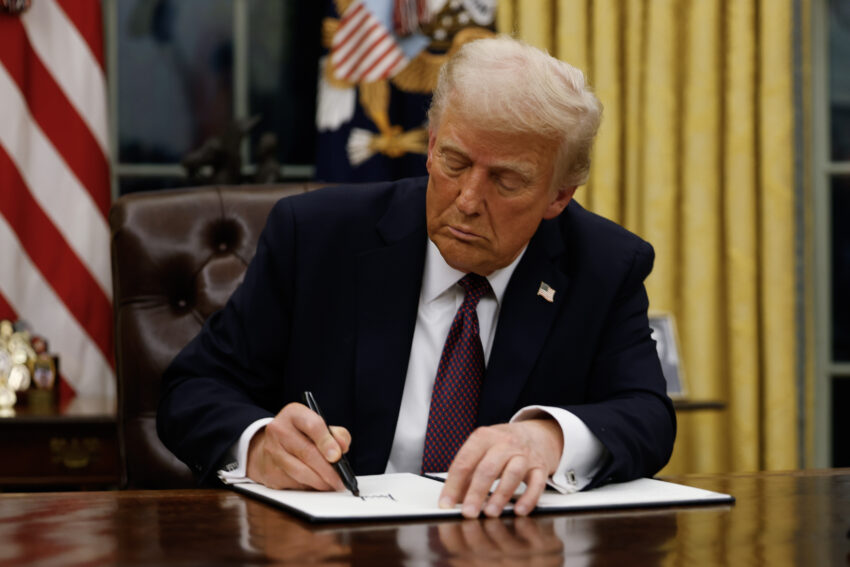
here s the trump executive order that President Donald Trump is poised to sign an executive order that would centralize the regulation of artificial intelligence (AI) at the federal level, effectively banning state-level AI laws.
here s the trump executive order that
Overview of the Executive Order
The executive order, which is expected to be signed as early as Friday, aims to establish a framework for federal oversight of AI technologies. A key component of this order is the creation of an “AI Litigation Task Force,” which would be overseen by the Attorney General. This task force will have the authority to challenge and potentially sue states that enact laws perceived to hinder the development and deployment of AI technologies.
Objectives of the AI Litigation Task Force
According to a draft of the executive order obtained by The Verge, the primary responsibility of the AI Litigation Task Force will be to identify and contest state laws that could obstruct the growth of the AI industry. The task force is expected to focus on laws that regulate AI safety and prevent algorithmic discrimination, which have been increasingly adopted by various states.
Targeted State Laws
Two specific state laws have been highlighted as potential targets for litigation:
- California’s AI Safety Laws: California has been at the forefront of AI regulation, implementing laws aimed at ensuring the safety and ethical use of AI technologies. These laws are designed to mitigate risks associated with AI, particularly in high-stakes areas such as healthcare and autonomous vehicles.
- Colorado’s Algorithmic Discrimination Law: Colorado has enacted legislation that seeks to prevent algorithmic discrimination, ensuring that AI systems do not perpetuate biases against certain groups. This law aims to promote fairness and transparency in AI decision-making processes.
The federal government’s challenge to these laws raises significant questions about the balance of power between state and federal authorities in regulating emerging technologies.
Implications of Centralized AI Regulation
The proposed executive order has far-reaching implications for the future of AI regulation in the United States. By centralizing authority over AI, the federal government aims to create a unified regulatory framework that could facilitate innovation and growth within the industry. However, this move also raises concerns about the potential for overreach and the undermining of state-level efforts to address specific issues related to AI.
Potential Benefits
Proponents of the executive order argue that a federal approach to AI regulation could streamline the regulatory process, making it easier for companies to navigate compliance requirements. Some potential benefits include:
- Consistency Across States: A unified federal framework could eliminate the patchwork of state laws that currently exists, providing clarity and consistency for businesses operating in multiple states.
- Encouragement of Innovation: By reducing regulatory burdens at the state level, the federal government hopes to encourage innovation and investment in AI technologies, fostering economic growth.
- Focus on National Standards: A centralized approach allows for the establishment of national standards for AI safety and ethics, ensuring that all AI technologies meet a minimum level of safety and accountability.
Concerns and Criticisms
Despite the potential benefits, the executive order has drawn criticism from various stakeholders, including state lawmakers, civil rights advocates, and technology experts. Key concerns include:
- Loss of Local Control: Critics argue that the executive order undermines state authority and local efforts to address specific challenges posed by AI technologies. States often have unique needs and contexts that may not be adequately addressed by a one-size-fits-all federal approach.
- Risk of Overregulation: There are fears that the federal government could impose overly stringent regulations that stifle innovation and limit the development of beneficial AI applications.
- Ethical Considerations: The focus on promoting industry growth may come at the expense of ethical considerations, such as fairness, accountability, and transparency in AI systems.
Stakeholder Reactions
The announcement of the executive order has elicited a range of reactions from various stakeholders in the technology sector, government, and civil society.
Technology Industry Response
Some technology companies have expressed cautious optimism about the potential for a unified regulatory framework. Industry leaders argue that a consistent set of federal regulations could reduce compliance costs and provide clarity for businesses investing in AI technologies. However, they also emphasize the importance of including input from diverse stakeholders in the regulatory process.
State Lawmakers’ Concerns
State lawmakers have voiced strong opposition to the executive order, arguing that it undermines their ability to protect their constituents from potential harms associated with AI technologies. Many state legislators believe that local governments are better positioned to understand and address the unique challenges posed by AI in their communities.
Civil Rights Advocates’ Perspectives
Civil rights advocates have raised alarms about the potential for the executive order to exacerbate existing inequalities. They argue that without robust state-level regulations, marginalized communities could be disproportionately affected by biased AI systems. Advocates stress the need for transparency and accountability in AI technologies to ensure that they do not perpetuate discrimination.
Historical Context of AI Regulation in the U.S.
The debate over AI regulation is not new. Over the past few years, various states have taken steps to regulate AI technologies in response to growing concerns about their impact on society. California and Colorado are among the states that have led the charge in establishing regulations aimed at ensuring the ethical use of AI.
State-Level Initiatives
Several states have implemented laws and initiatives aimed at addressing the challenges posed by AI:
- California: In addition to its AI safety laws, California has established guidelines for the ethical use of AI in public services, including law enforcement and healthcare.
- Illinois: Illinois has enacted the Artificial Intelligence Video Interview Act, which regulates the use of AI in job interviews to prevent discrimination.
- New York: New York City has implemented regulations requiring transparency in the use of AI in hiring processes, mandating that companies disclose when AI is used to evaluate job candidates.
These state-level initiatives reflect a growing recognition of the need for regulatory frameworks that address the ethical and societal implications of AI technologies.
Future of AI Regulation
The impending executive order marks a significant shift in the landscape of AI regulation in the United States. As the federal government seeks to assert its authority over AI, the balance of power between state and federal regulators will be tested.
Potential Outcomes
Several potential outcomes could arise from the implementation of the executive order:
- Increased Federal Oversight: The establishment of the AI Litigation Task Force could lead to increased federal oversight of AI technologies, potentially resulting in stricter regulations and enforcement actions against states.
- Legal Challenges: States may respond to the executive order by mounting legal challenges, arguing that the federal government is overstepping its authority and infringing on states’ rights to regulate emerging technologies.
- Collaborative Efforts: In the long term, there may be opportunities for collaboration between state and federal regulators to develop a comprehensive regulatory framework that balances innovation with ethical considerations.
Conclusion
The anticipated executive order represents a pivotal moment in the ongoing debate over AI regulation in the United States. As the federal government seeks to centralize authority over AI, the implications for innovation, ethical considerations, and state rights remain to be seen. Stakeholders across the spectrum will be closely monitoring developments as the landscape of AI regulation continues to evolve.
Source: Original report
Was this helpful?
Last Modified: November 20, 2025 at 5:37 am
3 views















